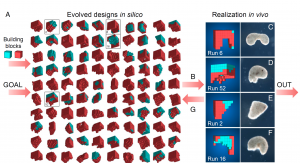Scientists have created the world’s first living, self-healing robots using stem cells from frogs.
Published on PNAS, a team of scientists from the University of Tufts and the University of Vermont created the first living robot named Xenobots without using any metals or plastics.
Those flesh robots constructed from frog cells can manipulate objects, move as directed and even interact with each other. The success of Xenobots promises advances in safe drug delivery, environmental remediation and understanding origins of life.
A New Star in Robotics
“They’re neither a traditional robot nor a known species of animal. It’s a new class of artifact: a living, programmable organism.”
explained by computer scientist Joshua Bongard, a collaborator of this project. Before Xenobots, genetic modifications on a single cell or 3D printing tissues have been attempted to construct living systems. Despite the success in simulating biological structures, those methods cannot predict any behaviors. So the question became how to construct a biological system that ‘knows’ what to behave.

A behavioral goal (e.g., maximize displacement), along with structural building blocks designed by computer. The blue and red regions indicate two types of cells. Source: PNAS
The Birth of Xenbots
Thanks to computer scientists, a method called ‘evolutionary algorism’ has been developed to achieve this goal.
During the robot design process, scientists first input some behavioral goals, for example, maximizing the moving area or leaving a hole in the center to carry drug molecules. The computer would then explore different building blocks with the assistance of evolutionary algorism. There are two types of frog cells for the building block, and by cleverly combining those cells, the robot may move as expected.

Xenobot under the microscope. The diameter is less than 1mm. Source: PNAS
Finally, from thousands of building block combinations, less than ten designs were selected for the experiment in vivo. The robots were manufactured under microscopy through a series of steps and tested in real conditions.
The result is surprising. Those robots can live for weeks in the water environment without additional energy. Once the energy dissipated, the cells die naturally and degrade as common organisms. Although they lack a nervous system, the robots can still change their motion regularly, and different individuals tend to exhibit various moving patterns.
 Video from the University of Vermont
Video from the University of Vermont
Will The Terminator Come True?
The incredible character of the living robot is the ability to self-repair in the face of damage. This feature is reflected in the Terminator, in which robots dominate the world.
Sam Kriegman, the first author of the study, admitted the moral issues brought by this project: the living robot variations may develop cognitive ability in the future. He also pointed out that, because this study is open to the public, society can discuss the topic and regulators should also formulate applicable policies. However, in the short term, this study is more likely to inspire future robotics and help us understand the innate creativity in life.
-Bokang Hou
